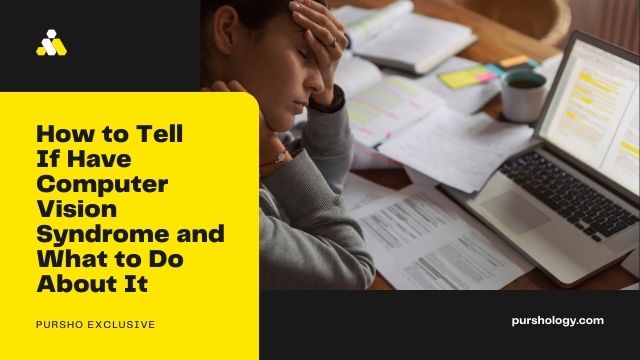Computers, the Internet, and smartphones make people’s lives easier. However, the overuse of digital electronic devices can have a negative effect on the eyes, especially when used for extended periods. This is especially true for people who work in jobs that entail staring at computer screens for several hours.
Ever heard of computer vision syndrome or CVS?
Often used interchangeably with ‘digital eye strain,’ the term encompasses various eye problems related to computer screens. According to ophthalmologists, CVS also covers a few other symptoms that may appear in parts of the body other than the eyes.
This article discusses signs that point to CVS and what you can do to remedy it.
Common Signs of Digital Eye Strain and What Causes It
Like carpal tunnel syndrome, CVS is a condition linked to work-related injuries because of repetitive motions.
Essentially, it occurs because the eyes follow the same path repeatedly. The condition could even get worse the longer you perform the movement.
This isn’t just limited to the back and forth of reading either. It can also result from having to look down to copy the papers and back up to the screen to check what you’re typing.
Plus, working in front of the computer causes your eyes to focus and refocus over and over.
You may not notice it, but your eyes react to the change in images, constantly moving, shifting focus, and rapidly sending signals to the brain. This can be quite tiring for the eye muscles.
You may also experience eye strain from the flicker, glare, and contrast of a screen – something you wouldn’t experience when reading from a piece of paper. That and the fact that you don’t blink as often as you should when working on a computer leads to digital eye strain.
Here are some of the common signs you need to watch out for to determine whether you have CVS:
- Your eyesight becomes blurry.
- You experience double vision.
- Your eyes become irritated, dry, or red.
- You experience frequent headaches.
- You feel neck, shoulder, and back pains.
Besides the screens themselves, computer vision syndrome could also be because of poor posture, poor lighting, and wrong screen viewing position.
Coupled with uncorrected vision problems, the discomfort you’re experiencing could get worse if left untreated.
5 Ways to Ease Digital Eye Strain
Although it’s a common condition, there are ways by which you can ease the symptoms of digital eye strain. The key is to correct the most common reasons it happens.
Below are five ways you can do just that:
1. Adjust your work setup.
The first thing you need to do is make sure your work setup is adjusted according to your comfort. This entails adjusting the computer screen distance, angle, and height.
- Adjust your distance from the computer so that your eyes are 20 to 28 inches away from the monitor.
- Place the screen four to five inches below eye level.
- Tilt the screen back about 10 to 20 degrees.
You can also prevent CVS by changing how light is distributed around you. If a nearby window casts a glaring effect, you can close the shades, hang a curtain, or move your monitor to avoid directly facing the bright window.
You can also install a dimmer switch in your home office or request it from your employer, especially if the overhead light is too bright. You can also buy a desk lamp with a moveable shade to distribute the light more evenly.
Changing the font style and size of the documents you read online can also help make them easier to read.
2. Increase your blink rate.
According to experts, 66 percent of users blink less when working in front of a computer screen.
Try to increase your blink rate to reduce your risk of dry eyes. Do it as frequently as possible to help keep the surface of the eyes moist.
3. Wear eye protection.
Eye protection isn’t just for athletes and people who work with chemicals and in places with debris. People working office and desk jobs also need computer protective glasses to keep their eyes safe from harm.
If you’re already wearing glasses, make sure that you have the correct prescription to prevent headaches and other signs of CVS. You can also pay a little extra to get the anti-glare feature in computer glasses (anti-reflective coating).
4. Correct your posture.
Poor posture also affects your chances of experiencing eye strain. Below are some tips on how to achieve the ideal posture:
- Sit straight up. Ensure that your ears align with your shoulders.
- Prevent your head and neck from leaning forward.
- Relax your shoulders and avoid slouching or hunching forward.
- Follow the ideal angle of your computer screen, with the monitor below eye level.
- Sit on a chair with the right height, allowing your feet to lie flat on the floor and your knees level or slightly higher than your hips.
- Invest in a chair with excellent back support.
5. Let your eyes rest.
Let your eyes rest according to the 20-20-20 rule. Have a 20-second break looking at something 20 feet away for every 20 minutes of screen time.
If that isn’t possible, you can also rest for 15 minutes after using your computer for two straight hours. While resting, it’s best to stand up from your work area and look at objects closer and further than your computer screen to “stretch” your eye muscles.
If you want to remain productive during your breaks, insert non-screen tasks like signing paperwork or delivering documents to other departments (the walk can also be quite refreshing).
Prevent Digital Eye Strain
Digital eye strain makes work more challenging.
To ensure that you stay productive while your eyes remain healthy, remember the information and tips shared here about computer vision syndrome. And don’t forget to ask your eye doctor about the best computer glasses for you.







